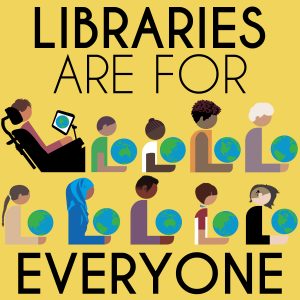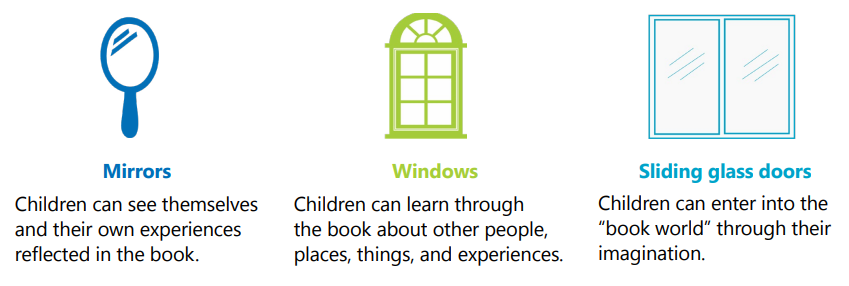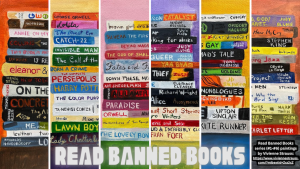
image source: Hafuboti
As I have learned more about the concept of a “hyperlinked library,” I have realized that it is woven into every aspect of librarianship and is the heart of what I find so important and special about librarianship: the ability – and responsibility – to create connections. When I think about creating connections, I think of how important it is for each person to feel welcomed and celebrated and to see themselves in their library. This can take on many forms, but in this blog post I will focus on library collections and how library materials, displays, and book-centered programs can foster an inclusive and welcoming library environment.
One concept that has stuck with me since early in my career as an educator is Dr. Rudine Sims Bishop’s idea of books being “mirrors, windows, and sliding glass doors.” In Sims Bishop’s (1990) article she states:
| “Books are sometimes windows, offering views of worlds that may be real or imagined, familiar or strange. These windows are also sliding glass doors, and readers have only to walk through in imagination to become part of whatever world has been created or recreated by the author. When lighting conditions are just right, however, a window can also be a mirror. Literature transforms human experience and reflects it back to us, and in that reflection we can see our own lives and experiences as part of the larger human experience. Reading, then, becomes a means of self-affirmation, and readers often seek their mirrors in books.” |

image source: Tandem
Books help us understand ourselves and our places in society, and they help us understand others. It is so important, then, that our book collections (and displays and programs) are wide, varied, and diverse. While specially-designated times – such as Black History Month, Jewish American Heritage Month, Asian American and Pacific Islander Heritage Month, Pride Month, Latine Heritage Month, and Native American Heritage Month – provide libraries with the opportunity to specifically highlight these communities, it is essential to create a safe and welcoming space all year long, through diverse and inclusive collections, displays, and programs.
To ensure that libraries serve as windows, mirrors, and sliding doors:
*learn about the identities, issues, and interests relevant to your community members, and collaborate with community organizations to provide personalized events and programs;
*include patrons in book selection;
*read diverse books aloud often, such as at storytimes and library events;
*include diverse people and cultures in all themes (for example: when highlighting water conservation/environmentalism, include books not only about local practices but also books about practices from various cultures and around the world);
*rethink what perspectives and positions are prioritized and privileged in books used in displays and programs (for example: when highlighting the fight for Civil Rights in America, include stories of the Black women who were not always at the forefront but were instrumental in the success of the Civil Rights Movement);
*examine which books and authors are most often spotlighted and promoted in your library, and ensure that displays include books written about diverse characters and by diverse authors, and include current stories and voices and not only books about cultures in faraway times and faraway places;
*ensure that books about diverse characters are about more than their identities; their cultures/identities are part of the story but are not the whole story (make sure we are not providing “foggy mirrors” or “too-small windows” (Enriquez, 2021));
*implement multimodal displays and programs – visual and performing arts, writing, digital composition, materials and programs designed for sensory-sensitive individuals and others for sensory-seeking individuals, etc. – to encourage engagement for all interests and ability levels
(Enriquez, 2021).
Here are some useful resources for creating inclusive libraries:
Overall
*Fostering Diversity: Public Libraries as Inclusive Spaces for Community Celebration
*Developing a Library That’s REALLY For Everyone
Collections
*Social Justice Books
*School Library Journal (Collection Diversity Audits)
Displays
*Increasing Circulation of Your Inclusive Library Collection
Programs
*Committing to Equity
*Accessible Library Programming Examples
*Programming Librarian

Read Banned Books, created by C. Kemeny Gambrell with artwork by Vivienne Strauss (used with permission): https://www.viviennestrauss.com
I can’t write about inclusive libraries without commenting on the disturbing increasing trend of book banning. In libraries across the United States, censorship and book banning has become a pervasive issue in recent years. In 2019, the American Library Association reported 377 book challenges; in 2022 that number was an alarming 1,269. According to PEN America (Meehan & Baêta, 2024), there have so far been more than 10,000 instances of book bans in the 2023-2024 school year. This number is nearly triple that of the previous school year (3,362). Organized groups are increasingly targeting library boards with disruptions and challenges at public comment sessions, primarily challenging diverse content such as books addressing racism and LGBTQIA+ issues (American Library Association, 2023).
Without access to these books, libraries cannot create inclusive spaces. However, even in areas where censorship is rampant, libraries can provide internet access, technology such as computers, laptops, iPads, and Wi-Fi, and the borrowing of e-books and audiobooks through programs and apps such as Overdrive, Libby, and Hoopla. Libraries in less hostile areas can also highlight diverse authors/works and books that have been banned/challenged. In April 2022, in response to increased efforts to remove books from library shelves, New York City’s Brooklyn Public Library (BPL) launched an initiative called “Books Unbanned,” giving teens and young adults aged 13-21 anywhere in the U.S. free access to BPL e-cards and the ability to borrow any e-book in BPL’s collection. Four other public libraries (Boston, L.A. County, San Diego, and Seattle) have since joined the program. Similarly, in July 2023, the Digital Public Library of America launched its “Banned Book Club,” which provides users with access to banned books in locations (in the U.S.) where titles have been banned (Parker, 2023). It is imperative that we act now to ensure that the right to read remains protected, through political advocacy for free expression, against censorship, and in support of libraries.
As saywhatnathan1 writes, “diversity means disruption” (2018). Creating truly welcoming and inclusive spaces requires intentionality and consistent reflection, examination, and evaluation, and it is all worth it to ensure that libraries truly are – and remain – a place for everyone!
References
American Library Association. (2023, March 22). American Library Association reports record number of demands to censor library books and materials in 2022 [Press release]. https://www.ala.org/news/press-releases/2023/03/record-book-bans-2022
Enriquez, G. (2021). Foggy mirrors, tiny windows, and heavy doors: Beyond diverse books toward meaningful literacy instruction. The Reading Teacher, 75(1), 103–106. https://doi.org/10.1002/trtr.2030
Hafuboti. (n.d.). Libraries are for everyone: English [image]. Retrieved on October 20, 2024, from https://www.hafuboti.com/2017/02/02/libraries-are-for-everyone/
Meehan, K., & Baêta, S. (2024, September 23). Memo on school book bans from PEN America. Pen America. https://pen.org/memo-on-school-book-bans-2023-2024-school-year/
Parker, C. (2023, July 25). Readers can now access books banned in their area for free with new app. Smithsonian Magazine. https://www.smithsonianmag.com/smart-news/banned-book-club-app-180982592/
saywhatnathan1. (2018, November 28). Diversity means distruption. Archival Decolonist. https://archivaldecolonist.org/2018/11/28/diversity-means-disruption/
Sims Bishop, R. (1990). Mirrors, windows, and sliding glass doors. Perspectives: Choosing and Using Books for the Classroom, 6(3). Retrieved from https://scenicregional.org/wp-content/uploads/2017/08/Mirrors-Windows-and-Sliding-Glass-Doors.pdf
Tandem. (n.d.). Mirrors windows doors graphic [image]. Retrieved on October 20, 2024, from https://www.tandembayarea.org/our-programs-2/book-collection/mirrors-windows-doors-graphic/

@Catherine The mirrors, windows, and sliding glass doors section was so interesting. Thhnansk for sharing that as part of your reflection and thanks for all the links! Saving this to go through them.